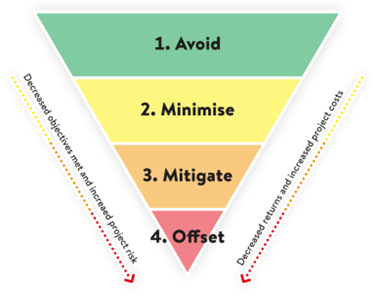Introduction
Achieving a balance between meeting renewable energy targets, climate change commitments and protecting and conserving biodiversity remains a delicate task for proponents and decision-makers.
The Victorian Department of Energy, Environment and Climate Action (Department) has released the draft Handbook for the development of renewable energy in Victoria (Handbook) alongside a discussion paper to help proponents and decision makers better manage the biodiversity impacts of renewable energy (Discussion Paper). Public consultation on the Handbook and the Discussion Paper closes on 16 February 2025.
The Handbook will form part of the proposed guidance to assist renewable energy proponents to improve siting, design and operation of their projects by giving more certainty on how to assess and manage the impacts of renewable energy (particularly wind energy) facilities on biodiversity, including impacts on brolga and bats (Proposed Guidance).
The Proposed Guidance is intended to be used in designing project proposals and in the environment and planning assessment and approval processes. Ideally, where renewable energy proponents take the Proposed Guidance into account, it will be easier to obtain the necessary environmental and planning approvals.
The Proposed Guidance aims to facilitate the development of renewable energy in Victoria by:
- Adopting a risk-based and proportionate approach to the management of biodiversity impacts from renewable energy development.
- Clarifying Government priorities and expectations, with an emphasis on achieving a ‘no net loss’ outcome for species identified most at risk (i.e. Species of Concern).
- Providing information and guidance for proponents around utilising the mitigation hierarchy to avoid, minimise, mitigate and offset or compensate for biodiversity impacts.
- Establishing a new risk assessment framework supported by improved spatial analysis tools to enable proponents to minimise their impacts through site selection, to avoid areas of significant biodiversity value.
This legal update provides an overview of the Proposed Guidance and its role in Victoria’s existing regulatory framework.
Background – regulatory context
Renewable energy facilities require a number of permissions. In particular, wind energy facilities in Victoria require a planning permission, usually a planning permit under the Planning and Environment Act 1987 (Vic). In addition, depending on siting, consideration is required of how a project aims to protect and enhance biodiversity, and how a project impacts listed species of flora and fauna under both the Flora and Fauna Guarantee Act 1988 (Vic) (FFG Act) and the Environment Protection and Biodiversity Conservation Act 1999 (Cth) (EPBC Act).
Further, the Environment Effects Act 1978 (Vic) (EE Act) provides that where proposed project works are capable of having a significant environmental effect, an environmental impact assessment must be conducted and an Environment Effects Statement or Environmental Report provided to the Minister for Planning, to inform final project planning approvals or other necessary permissions.
A joint statement by the Ministers for Climate Action, Environment and Planning in April 2024 (Joint Minister’s Statement) set out a joint Ministerial approach to balancing the need for biodiversity protection, with the need to meet renewable energy targets. The Joint Minister’s Statement came alongside the announcement that renewable energy projects could be fast-tracked through the Development Facilitation Program (DFP) with the inclusion of renewable energy facilities (and utility installation projects) with an installed capacity of 1 MW or more in clause 53.22 of the Victorian Planning Provisions (Significant Economic Development). Expanding the DFP to include renewable energy projects aims to reduce planning permit timeframes by avoiding determination by a planning panel process or such projects not being subject to thirty party appeals in the Victorian Civil and Administrative Tribunal.
Proposed guidance – the handbook
The Handbook predominantly focuses on the biodiversity impacts of onshore wind projects (but can apply to other renewable energy developments) and proposes these risks be managed by:
- Applying the mitigation hierarchy
- Establishing the biodiversity risk using certain criteria
- Identifying the impacts of projects on species at particular risk from the development of renewable energy facilities due to their status, location or behaviour (Species of Concern):
- A proposed list of the Species of Concern can be found here.
- For Species of Concern, it is proposed that proponents will have to demonstrate that there is ‘no net loss’ to the Species of Concern (which is likely to require a demonstration that the mitigation hierarchy has been applied).
We address aspects relating to Species of Concern, and then consider the mitigation hierarchy and biodiversity risk.
Species of Concern
For threatened Species of Concern that are considered most at risk a ‘no net loss’ objective must be met. This requires proponents to apply the mitigation hierarchy to achieve the ‘no net loss’ objective.
The ‘no net loss’ objective is the Department’s preferred option to apply to Species of Concern because the impacts on biodiversity caused by the development are to be balanced with measures undertaken under the mitigation hierarchy (to avoid, minimise and mitigate impacts). Offsets will only be available for the residual impacts so that there is no ‘net loss’ to Species of Concern. One of the reasons this option is preferred is because it will ensure proponents who develop a project at a later stage than others in an area potentially containing Species of Concern will not have to manage the additional regulatory burden of ‘cumulative impacts’ from previous developments.
The proposed list of Species of Concern can be accessed via Engage Victoria here, and will be updated by the Department in the future.
Managing certain Species of Concern, particularly brolga and bats has attracted consideration attention in recent times.
There have been a number of cases internationally and locally that consider the impact of the development of wind facilities on protected birds and bats. In Australia, the case involving the Willatook Wind Farm (see our previous update here) resulted in specific conditions being recommended to manage impacts to brolga and bats, including by increasing turbine free buffer areas and significant construction moratorium periods.
Extensive public consultation was undertaken on the Interim Brolga Guidelines in 2020. While the Handbook will incorporate species specific guidelines for brolga and bats, these guidelines are still being developed and are not included in the Handbook. While no further feedback is currently sought on the Interim Brolga Guidelines, the Handbook seeks some feedback on aspects relating to bats.
Species specific plans for managing the impacts on bats and brolga, including a Bat and Avifauna Management plan template, are proposed to be annexed to the Handbook but have yet to be released.
Other species
Where a proposed renewable energy facility is likely to impact:
- A species with cultural significance, proponents are encouraged to consult with Traditional Owners as part of their design and planning process.
- Threatened species not on the list of Species of Concern, that are considered lower risk may require monitoring and reporting of these species.
Applying the mitigation hierarchy
As an internationally recognised tool for addressing biodiversity impacts, the mitigation hierarchy prioritises prevention to avoid and minimise biodiversity impacts to the maximum extent practicable, and is currently already applied through environmental assessments under the EPBC Act, the EE Act and in the 2017 Guidelines for removal, destruction or lopping of native vegetation.
In effect, it means that direct or indirect offsets can only be utilised as a last resort to address residual impacts from a development. The Handbook further proposes implementing a limit on the use of indirect offsets (limiting their application).
Mitigation Hierarchy Diagram

Source: Buro Happold
The Handbook gives a range of ways in which the mitigation hierarchy will apply, from avoidance measures like strategic site selection to minimisation measures such as aligning turbines parallel to bird migration routes or general flight directions.
The mitigation measures listed in the Handbook could impact the costs and viability of renewable energy project proposals in a significant way, and include the following options:
- Low wind speed curtailment to increase cut-in speed during identified risk periods for bats
- Locking the blades below cut in speed
- On demand shutdown of turbines in real time when a species is detected as approaching turbines and at risk of collision
- Installation of acoustic deterrent devices to deter species
- Increased visibility of infrastructure to warn bird species of its presence
- Minimising potential for bats or birds to be attracted to the facility through limiting access to water and the periodic clearance of carcasses
Establishing biodiversity risk using the Biodiversity Risk Criteria
To assist proponents to select sites in areas with the least biodiversity value, the Handbook sets out criteria for categorising individual development sites across a scale of high to low risk. It also proposes that renewable energy projects that impact fewer biodiversity values will face a less cumbersome environmental assessment process, thereby obtaining permissions to operate the facility faster.
Various tools in establishing the Biodiversity Risk Criteria will allow proponents to ‘avoid’ impacts to biodiversity to the extent possible through informing site selection. A breakdown of these tools is below:
Criteria 1 – Biodiversity Values Map
- The Department has developed the Habitat Values Map and the Marine Biodiversity Values Map to consider the relative biodiversity values in different areas. The Biodiversity Values Maps, developed by the Department, provide decision makers with an objective and comprehensive view of areas of biodiversity importance across Victoria. They can be used by proponents to assess the relative value of biodiversity, aiding the design of renewable infrastructure that minimises impacts.
Criteria 2 – Proximity to areas of significant conservation value
- A project in close proximity to areas of significant biodiversity value, for example, a world heritage site or an established native vegetation offset site, comes with a higher degree of risk, even where the project site itself is of minimal value.
Criteria 3 – heightened risk to Species of Concern
- This considers whether an examination of the biodiversity characteristics of a proposed site suggests a heightened risk to Species of Concern.
- The specific conditions of the site may represent a ‘heightened risk’ to a Species of Concern when considering the following:
- Multiple Species of Concern are present at the site or in the surrounding area.
- A Species of Concern found on site is listed as ‘Critically Endangered’ under the FFG Act.
- Information and/or data provided by the proponent fails to meet any requirements or methodology published by the Department.
- There is a limited understanding/knowledge of critical aspects of a certain species (e.g., behaviour, population dynamics).
- Similar nearby facilities have reported mortalities of a Species of Concern and presence of that species has also been recorded at the site.
While biodiversity risk is assessed on an individual basis, the Handbook considers that it is likely that a ‘low risk’ development is less likely to encounter the challenges a ‘high risk’ development would in achieving the ‘no net loss’ objective.
How will the Handbook apply
At this stage, it is not anticipated that the Handbook will be incorporated into the Victoria Planning Provisions. This means that the Handbook is likely to act as a guideline only, that will not be formally binding in planning and environmental assessments for renewable energy developments in Victoria, although this may occur in future.
The Department is currently considering how best to transition to the Proposed Guidance, and whether transitional provisions are required to specify how the Proposed Guidance would apply to projects currently progressing through environmental and planning assessment and approval processes. Options being considered include:
- Specifying a particular timeframe for commencement from the date the guidance is published.
- Linking the transitional provisions to a determination of the requirement for an Environment Effects Statement under the EE Act– meaning proposals that have had the requirement for an EES determined within one year of the commencement of the Proposed Guidance will continue to be assessed under the current guidance.
Ultimately, we anticipate that where renewable energy proponents adopt the Proposed Guidance, this will make it easier to obtain the necessary permissions to develop, construct and operate a renewable energy facility in Victoria.
Next Steps
Public consultation on the Proposed Guidance, which includes the Handbook and Discussion Paper, closes on 16 February 2025.
If you are interested in making submissions, please contact a member of our Environment and Planning team.









